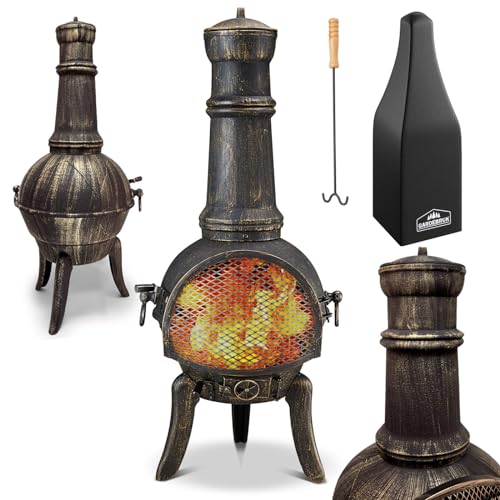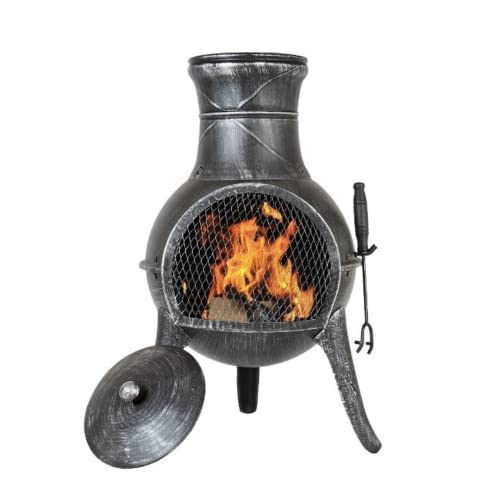Things You Should Know Before Buying a Chiminea
Chimineas are a great addition to your backyard. They add warmth and ambience. However, there are a few things to know prior to purchasing one.
For instance, some Chimineas emit harmful particles into the air. It is possible to avoid this by using eco-friendly fuels such as bioethanol fire pits. They also require regular maintenance.
The History of the Chiminea
Chimineas are a popular option for outdoor living spaces, warming them up and emitting the warm glow of an open fire. They can transform an evening of cold and dark into a cozy space to entertain family and friends or just relaxing. The first chimineas were made of clay and other materials, chimineas have developed to accommodate various aesthetic and functional requirements throughout the years.
Traditionally, chimineas have the shape of a potbelly and a chimney, but they are also available in
Modern Chiminea styles that have a more open design. They typically sit on a foundation that lifts them off the ground. They also have a wide opening to add firewood. Some chimineas are plain, while others have painted, raised or incised details.
The first chimineas, constructed of fired clay were used for heating and cooking. As they became more popular they were adapted to accommodate different climates. The advancements in design and construction techniques made them more robust. Chimineas are now available in various stones, metals, and clays, each having distinct aesthetic and practical benefits.
Based on the type of chiminea you choose It may require regular maintenance to ensure it is in good condition. Clay chimineas, for example can crack over time if not properly stored during the winter. To protect them, use a sealant for protection that has been specifically designed for clay and reapply it every 3 months to ensure maximum protection.
Metal chimineas can be damaged however they can also crack if they are not stored correctly. To avoid this, keep them in a protected area that shields them from the elements as well as any snow or rain that might fall. To keep it from falling over, put the chiminea on a sturdy and level surface. It should not be placed under trees or other structures like a roof or the patio.
Ultimately, chimineas should be installed permanently in their desired location and should not be moved frequently as they are extremely heavy and are difficult to move. However, you can easily move smaller clay chimineas between different areas of your garden or backyard.
Their Function
Originally designed as functional cooking vessels for the town-dwelling Mexican tribes These outdoor fireplaces are perfect for creating a cosy ambience. They can also be used as heaters by distributing heat through their chimney systems. Their aesthetic versatility allows them to complement a wide variety of styles.
In addition, chimineas are easy to maintain and manage making them less prone to constant cleaning. They also can last longer when they are properly maintained and protected from extreme weather conditions. However, the quality of the materials used and the maintenance techniques employed by homeowners will determine their longevity.
 chimineas sale
chimineas sale come in a variety of materials including traditional clay as well as cast iron and steel and all of them offer distinct durability and aesthetics. The latter, for example are more polished and refined look that suits modern designs. They also retain heat exceptionally well which enhances their functionality as outdoor heating. Some are also made of eco-friendly materials and offer an alternative to fossil fuels.
The impact of Chimineas on air quality is contingent on factors such as the duration of use, the kind and amount of moisture in the wood, as and the effectiveness of the design. These units emit particulate emission which can be harmful to the health of people and contribute to air pollution. Making use of dry, seasoned wood and using a chiminea that is efficient in its design can greatly reduce the impact.
Unlike fire pits, which offer an open and awe-inspiring experience, chimineas are enclosed structures that minimise smoke production. They also are designed to direct smoke upwards, mitigating potential health concerns and neighbourly nuisances. The open design of firepits could cause a lot of smoke that can affect living spaces.
The decision to choose between a chiminea and a firepit ultimately comes down to the budget, your personal preferences and the functionality. Both units are versatile and offer an unique design. Chimineas are an excellent option for those who wish to create a cozy atmosphere with little effort. Because of their special design they are much easier to use once heated up and are a great alternative to outdoor fire pits.
Materials
Chimineas are available in a variety of styles that will suit any preference. They are usually designed with the potbelly which tapers to a chimney. They can be constructed from clay, metal or cast iron. They are a great addition to any deck or patio that you have in your backyard. They can provide illumination and ambience while giving warmth, which allows you to spend more time outdoors. Chimineas are frequently utilized as an alternative to fire pits due to their more visual appeal and do a better job of funneling smoke away from those who are sitting around it.
Clay chimineas are made by hand using raw clay from the locality. They are then fired in a kiln to burn off any leftover materials and form a hard, water resistant surface. Then they are then coated with a protective glaze that lowers the chance of them cracking or warping. A chiminea can be stored outdoors all year long with the exception of extreme weather. If it is stored outside, the clay should be covered and protected with the Chiminea.
If it is made of clay, metal or cast iron, a
chiminea fire pit can provide a rustic, elegant style to your patio. They are made to withstand high temperatures, making them ideal for cooking, and they come in a variety sizes. Some even come with a removable BBQ.
Before purchasing a chiminea, ensure that it is safe to use and has proper ventilation. It is crucial to keep it on a noncombustible surface, such as concrete patios or bricks. It shouldn't be placed under an overhang such as a roof or pergola. It is important not to use water to extinguish the flames because the sudden temperature change can crack terracotta and clay.

Although chimineas can withstand temperatures outside, they should be broken down slowly by lighting small fires and increasing the size of the fire gradually. To avoid rust and ash accumulation It is recommended for you to clean your chiminea frequently by using an outdoor wood cleaner.
Environmental Impact
Chimineas are well-known for adding warmth and ambiance to outdoor living spaces, however there is a concern that their use produces harmful gases. The burning of wood in chimineas emits carbon monoxide which is a deadly gas that has no smell and is inert and can cause various health issues, including respiratory issues.
This gas is particularly dangerous in enclosed structures like Chimineas, where it may build up to levels that are toxic. It can cause carbon monoxide poisoning that can cause unconsciousness or death. It can also contribute to air pollution and global heating and is the reason chimineas should be kept outdoors and away from any flammable items.
In addition to carbon monoxide, chimneys also emit particulate matter and other harmful pollutants. The size of the chiminea as well as the fuel used influence the quantity of emissions. Dry wood fuels produce less emissions than wet logs. A chiminea fitted with a spark resistor will cut down smoke and PM2.5 emissions.
Although chimineas have evolved throughout the years, their quintessential design -- a pot-belly base and an elongated chimney -is still in place. This balance of aesthetics, preservation, and innovation is what has made the chimineas so beloved in Europe and all over the world.
Modern chimineas come in a variety of styles and materials that can be adapted to any garden style. While clay chimineas are still popular, many prefer metal versions that offer greater durability and weather resistance. They can be made of cast iron, cast aluminum or even stainless steel. They can be shaped according to your taste.
There are also linear and slim designs that will not sacrifice performance. It is important to remember that a chiminea made of metal requires more frequent maintenance and care than a clay model, since it will be exposed to thermal shock each time you start it up.
When selecting a chiminea it is recommended that you study the manufacturer's guidelines carefully before igniting a fire. It is also recommended to cover your chiminea to prevent dust and water damage. It is also crucial to regularly clean your
best chiminea and remove any ash before you start an entirely new
fire chiminea.

 chimineas sale come in a variety of materials including traditional clay as well as cast iron and steel and all of them offer distinct durability and aesthetics. The latter, for example are more polished and refined look that suits modern designs. They also retain heat exceptionally well which enhances their functionality as outdoor heating. Some are also made of eco-friendly materials and offer an alternative to fossil fuels.
chimineas sale come in a variety of materials including traditional clay as well as cast iron and steel and all of them offer distinct durability and aesthetics. The latter, for example are more polished and refined look that suits modern designs. They also retain heat exceptionally well which enhances their functionality as outdoor heating. Some are also made of eco-friendly materials and offer an alternative to fossil fuels. Although chimineas can withstand temperatures outside, they should be broken down slowly by lighting small fires and increasing the size of the fire gradually. To avoid rust and ash accumulation It is recommended for you to clean your chiminea frequently by using an outdoor wood cleaner.
Although chimineas can withstand temperatures outside, they should be broken down slowly by lighting small fires and increasing the size of the fire gradually. To avoid rust and ash accumulation It is recommended for you to clean your chiminea frequently by using an outdoor wood cleaner.